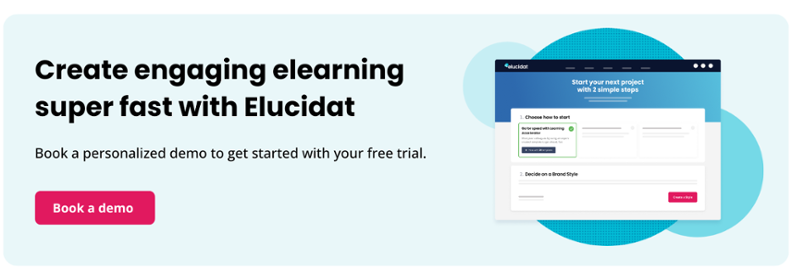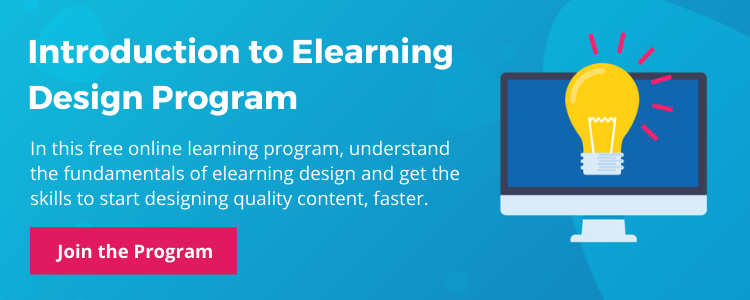5 inspiring scenario-based elearning examples
8 minute read
Scenarios can be an effective way to engage your learners and really change their behavior. Here are five scenario-based elearning examples to inspire your next project.

What is scenario-based learning?
Scenario-based training is a form of training which focuses on learning by doing. It uses real-life situations to support active learning. Rather than passively absorbing information, learners are immersed in a story. Using realistic work situations provides relatable, relevant, and impactful learning experiences. Adding interactivity to the scenario enables users to make decisions and learn through experiencing the consequences of their choices.
From compliance to soft skills, scenario-based learning can be applied to meet most corporate training needs. It can be your main learning strategy or part of a flexible blended learning journey. The approach can be used in online training for the workplace, as well as to enrich face-to-face training and Virtual Instructor Led Training (VILT). Scenarios can be set up using simple text with images, more immersive videos or even Virtual Reality (VR).
Why use scenario-based training?
Scenario-based learning is a popular strategy for online training. It offers lots of advantages for colleagues and companies.
Here are our top benefits of scenario-based training:
- Context: Learning is more effective if it’s real, relevant and practical. Set in situations that are familiar to learners, and acknowledging the nuance involved in their choices, makes the learning easier to transfer to the real world.
- Engagement: Humans respond well to emotionally impactful and memorable stories. A well-constructed realistic scenario will fuel a learner’s motivation. Realistic characters and a relevant storyline will keep learners engaged. They’ll want to find out what happens next and see the outcome of their choices.
- A safe space: Learners can make mistakes and take remedial action to recover in a safe online simulation. This approach can be used to explore situations that might be too risky, difficult, sensitive or expensive to explore in real life.
How to use scenario-based learning?
There are lots of ways to include scenarios in your elearning design, from quick and simple to longer-form and intricately designed.
So, where do you start?
- Understand your learning needs: Begin by understanding the problem you’re trying to solve and the audience you’re targeting. This will help you identify an approach that will resonate and create real business impact.
- Explore the critical situations: Speak to your colleagues and find out where and why work situations might prove challenging. Identify what triggers the event as this will be the starting point of your scenario.
- Identify the decision points: Walk through the work situation. Pinpoint the key decision points and the motivations behind these decisions. Identify the common mistakes that people make and the key feedback and reflection points that should be highlighted.
5 scenario-based elearning examples
Once you’ve analyzed your learning needs and outlined your scenario, it’s time to design your learning.
Here are five scenario-based elearning examples, each with a different approach, to get you inspired.
1. Scenario-based learning at scale
When working with a high volume of learners, small tweaks can make all the difference. By giving learners a range of choices to explore, this scenario based elearning example feels more relevant and personal to each individual. By allowing them to ‘work’ a case and draw their own conclusions they are drawn through the story and have autonomy in how they approach their learning.
Scenario-based learning example:
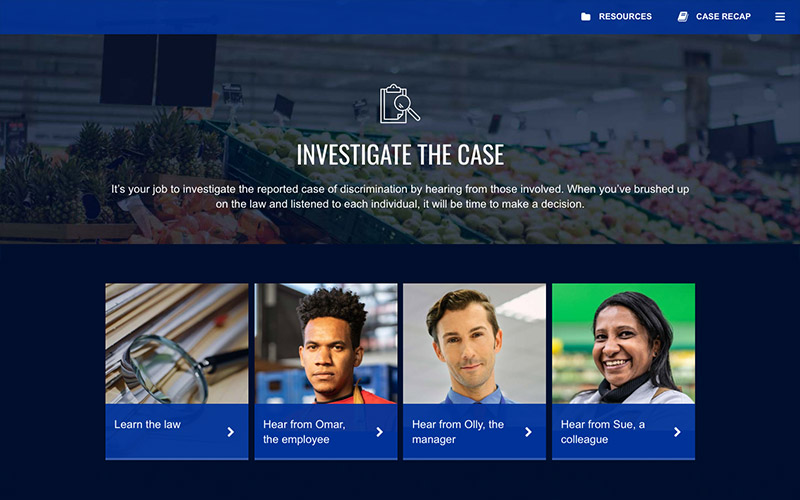
A great scenario-based approach for:
- Large organizations with multiple or diverse audiences in different environments
- Addressing nuanced topics where learners need to see several viewpoints. Think ethics training, discrimination or health and safety.
See this scale-friendly elehttps://www.elucidat.com/showcase/#scenario-based-learning-at-scalearning example
2. Story as a way into the substance
A scenario can be a great way into a topic that is complex, dry or otherwise tricky. In this example, the story draws the learner in and primes them for the core content about ethical dilemmas and decision making.

Why it works:
- The (true) story has suspense and drama without being contrived or unbelievable, and music clips and engaging visuals bring it to life
- Decision points with immediate feedback in the narrator’s voice maintain immersion and the momentum of the story
- At the end, those low-stakes decisions are played back with commentary on what they might suggest about the learner’s responses in higher-stakes situations
- There is no judgment given – the scenario is all about drawing the learner in, prompting some self-reflection and priming them for the true learning content to come
- A low-tech interactive scenario makes a big, potentially daunting, topic accessible and engaging
Click here to go to this example
3. Product training using a sales simulation
When you need to train staff up on a new product, you could just give them the product information. But this elearning scenario example shows how taking a scenario-based approach to test that knowledge can be more engaging and more effective.
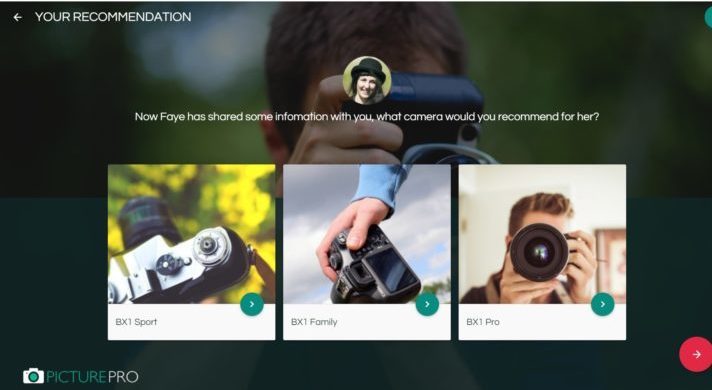
Why it works:
- Applying a simple scenario turns a basic multiple choice quiz into a more challenging simulation
- The quiz module tests the learner’s sales skills and ability to apply the learning in context, rather than simple recall of facts
- Using a customer scenario brings the content to life and helps to embed the product knowledge
- Feedback directs the learner back to the product information if the learner choose incorrectly, reinforcing the learning rather than just giving the correct answer
Click here to go to this example
4. Immersive branching scenarios to explore consequences
Sometimes it pays to develop a more immersive, branching scenario – like this Open University example. This works really well when you want to offer experiential learning online and need the learner to engage emotionally with a subject.
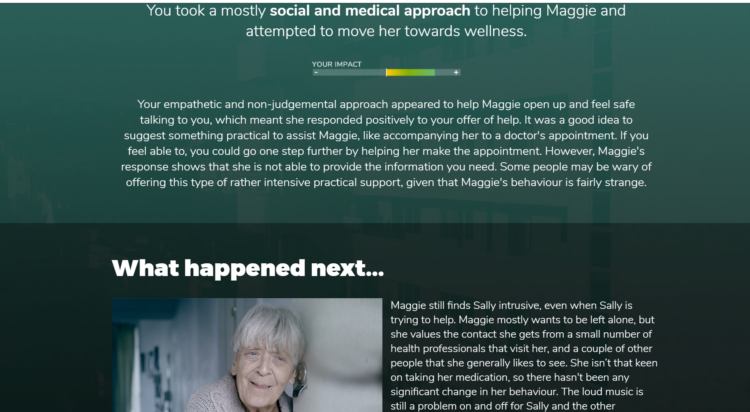
Why it works:
- It combines Elucidat’s video players, rules, branching, social polls and layout designer to immerse the user in each emotionally-charged scenario
- The user learns by doing: their choices control the story and they see and feel the impact of their decisions on other people
- Feedback is offered at the end rather than incrementally after each decision point, so the branching is seamless and the story more realistic and engaging
- The use of scenarios makes the topic of mental health much more real, impactful and high stakes than simply reading about it
- As this is a topic where there isn’t a single right answer, social polling adds an extra dimension to the scenario by showing how other people acted at various points
Click here to go to this example
5. An audio-driven scenario with game elements
This demo shows how gaming mechanics such as points and timers can be added to a scenario to create a realistic simulated environment for salespeople to practice their skills.
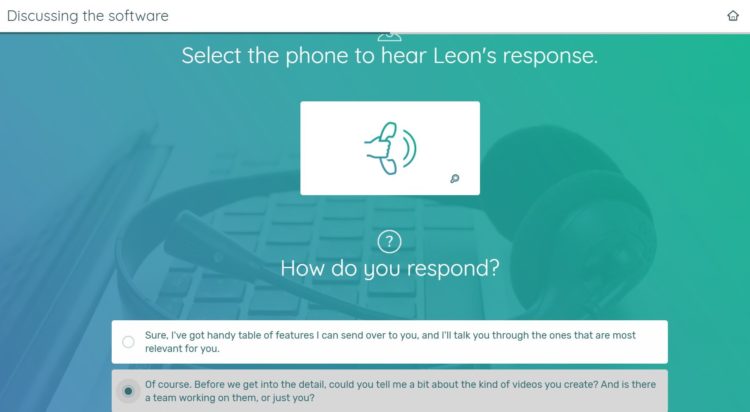
Why it works:
- This scenario is audio-driven, which balances low cost and engagement and – more importantly – simulates the environment the learners work in
- The whole scenario is in the first-person: the learner isn’t controlling a character or reacting to an observed scenario; they are the character and it’s their scenario
- Game elements add a sense of competition and urgency to the scenario, bringing it closer to the reality of a fast-paced, target-driven sales floor
Five examples of scenarios in corporate elearning, each used in a different way. If you need to make your content more engaging, more impactful, more relevant, and relatable, incorporating elearning scenarios could be the way to go. See how you can implement scenario examples with this best practice guide.
When to use scenarios to add value to your elearning?
In a nutshell, incorporating storytelling into your workplace learning content makes it more engaging, emotionally impactful and memorable. Crucially, it also makes it more effective: real, relevant and practical scenarios mean the knowledge and skills learnt are more likely to be transferred to the workplace.
Here are some examples of situations in which scenarios could really add value to the learning experience, and the potential benefits:
- When learner motivation is low. When learners simply don’t care, a well-designed scenario plays on their natural curiosity and that human tendency to want to know what happens next and where the story goes. A good scenario also encourages intrinsic motivation by striking a balance between challenging learners (to use existing skills and knowledge) without overwhelming them: success (and new skills or knowledge) has to feel within reach.
- When the core content is dry or complex: legal topics, compliance and so on. It can be hard for learners to envisage how this content relates to their everyday life. Opening with a story illustrating the relevance and why it matters is so much more effective than just stating the facts. It means the core content, when it comes, is more likely to stick, and it provides a memorable hook for that core content. This helps with the transfer from short-term to long-term memory.
- When you’re tackling a risky or sensitive topic – like mental health, diversity and difficult conversations. When the stakes are high in real life, safe exploration before the fact is key. Learners can have as many attempts as they need, making mistakes and playing through the consequences, without any real-life risks. These topics often lend themselves well to branching scenarios with multiple paths so learners can try out a number of approaches in a safe environment.
- When there isn’t a single right answer. Scenarios, again particularly branching scenarios, can be a great choice when you want to encourage reflection and discovery, test learners’ assumptions and encourage them to consider different perspectives. This is often the case with soft skills like leadership or negotiation. Social polling can add a useful extra dimension here too, showing learners how other people responded in the same situation and prompting further thought and reflection.
- When you need to test learners’ ability to apply the learning in context. Sales skills, product knowledge and customer service skills are good examples of this. A traditional multiple-choice quiz tests recall of facts but does nothing to indicate what learners can do with those facts. Adding a scenario into the mix turns a quiz into a more challenging situation, giving you confidence that – if they perform well here – they’ll perform well where it counts. It also makes it easier for learners to transfer the concepts to their real-life context.
Start creating your own scenario-based elearning courses
Feeling inspired? Ask us for a free trial of Elucidat and see what you can do. And, while you play around with your free version, don’t forget to compare us with other software out there. Just check out our best elearning authoring tools blog and get the low down on what’s out there.
Looking to take your elearning design skills to the next level? Try this certified engaging elearning course to get started.
